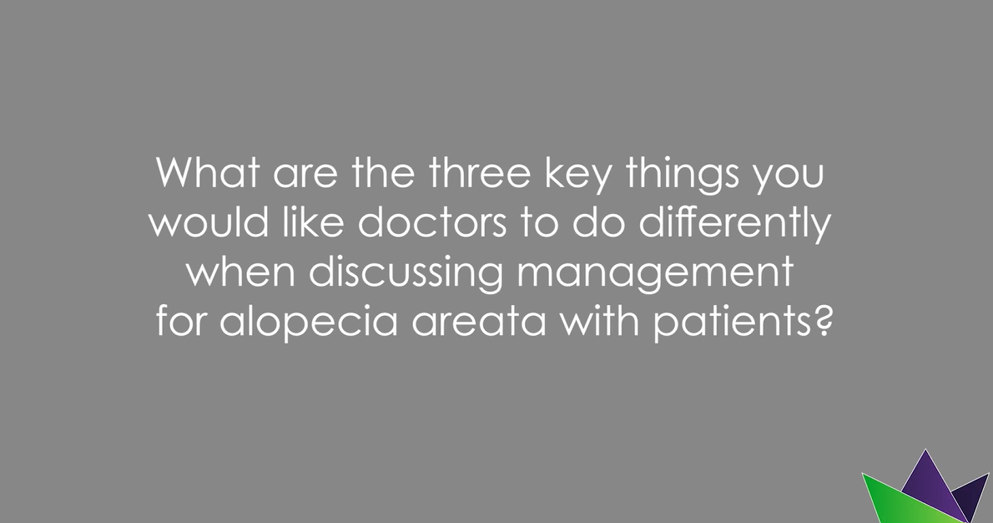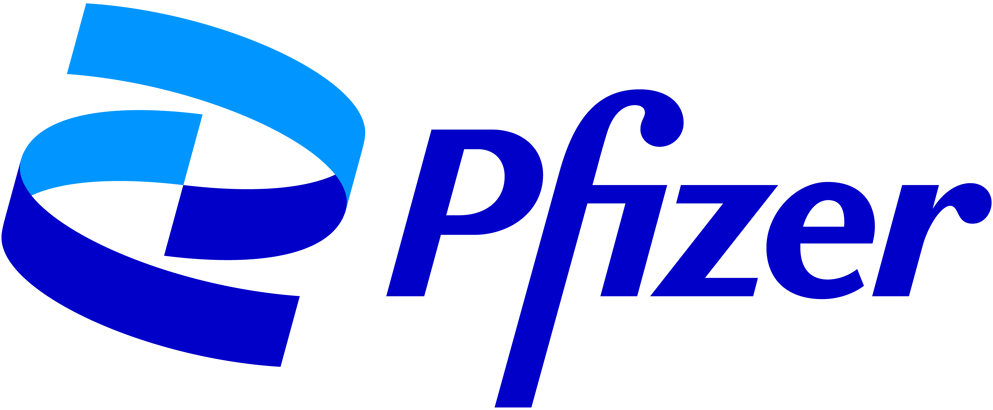
Unmet treatment needs for alopecia areata
Unmet treatment needs for alopecia areata
In this video, Lynn Wilks, a patient with alopecia areata, discusses unmet patient needs for this condition and three key things she wants clinicians to do differently when discussing management for alopecia areata.
Watch Lynn's full interview here
Unmet treatment needs for alopecia areata
There is no cure for alopecia areata (AA), and there is an unmet need for long-term effective and tolerable treatments for managing this condition. One indicator of this unmet need is patient dissatisfaction with current therapies for AA1.
As surveyed by dermatologists in the US, common reasons for patient dissatisfaction with treatments for AA are as follows1:
- Lack of treatment efficacy (73%)
- AA impacting patient quality of life (50%)
- Slow onset of action (37%)
- Patient not satisfied (33%)
Patient dissatisfaction is greater in relation to more severe AA (17% satisfaction), due to poor or failed hair regrowth following treatment, and the adverse impact of AA on patient quality of life (Figure 1)1.
Figure 1. Patient attitudes towards treatment options for alopecia areata (Adapted1).
A consequence of this unmet need is that patients with AA are frequently switched from one treatment to another, due to poor or no effective response (Figure 2)1.
Figure 2. Patients switch treatments for alopecia areata frequently in the absence of hair regrowth following therapy (Adapted1). *‘Other’ includes soralen and ultraviolet radiation A, ultraviolet radiation A, panretinal photocoagulation, vitamins, minoxidil, finasteride, iron, bimatoprost or simvastatin/ezetimibe.
Common reasons for severe AA patient dissatisfaction are the side effects of oral corticosteroids (40%) and the mode of administration with immunomodulators (25%)1. Overall dissatisfaction with treatment is prominent (14% dissatisfied, 29% neutral), and increases with AA severity (Figure 3)1.
Figure 3. Patient attitudes about current alopecia areata (AA) treatments by AA severity and overall (total) (Adapted1).
Responding to unmet needs: FDA approval of baricitinib for severe AA
In 2022, the U.S. Food and Drug Administration (FDA) approved the Janus kinase (JAK) inhibitor baricitinib oral tablet for adults with severe or very severe AA2,3, following completion of the pivotal clinical trials BRAVE-AA1 and BRAVE-AA24-6.
In BRAVE-AA1 (N = 654 enrolled), 22.8% (n = 184) of patients on 2 mg baricitinib and 38.8% (n = 281) of patients on 4 mg baricitinib achieved a SALT score of 20 or less at Week 36, compared with 6.2% in the placebo group (n = 189)6.
In BRAVE-AA2 (N = 546 enrolled), 19.4% (n = 156) of patients who received 2 mg baricitinib and 35.9% (n = 234) of patients on 4 mg baricitinib achieved a SALT score of 20 or less at Week 36, compared with 3.3% of patients on placebo (n = 156)6.
In BRAVE-AA1 and BRAVE-AA2, the most common side effects associated with baricitinib were upper respiratory tract infection, headache, acne, high cholesterol (hyperlipidaemia), increase of creatinine phosphokinase and urinary tract infection6.
Baricitinib is not indicated for combined use with other JAK inhibitors, biologic immunomodulators, cyclosporine or other immunosuppressants3.
Continue to the next section to learn about more drugs for AA under clinical trial investigation.
Future of alopecia areata management
Join Dr Brett King (Associate Professor of Dermatology, Yale School of Medicine, US) for a discussion on the future of alopecia areata management.
Janus kinase inhibitors for alopecia areata under development
Ritlecitinib
- Ritlecitinib is an investigational covalent Janus kinase 3 (JAK3)/TEC family kinase inhibitor, with high selectivity for JAK3
- In the Phase 2b/3 ALLEGRO trial, ritlecitinib met the primary efficacy endpoint of improving scalp hair regrowth7
- A statistically significant proportion of patients on ritlecitinib had 20% or less scalp hair loss (absolute Severity of Alopecia Tool [SALT] score ≤20) following 24 weeks of treatment, compared with placebo7
- Common adverse reactions reported in ALLEGRO were nasopharyngitis, headache and upper respiratory tract infection7
Deuruxolitinib
- Deuruxolitinib is an investigational selective oral JAK1/JAK2 inhibitor, modified from ruxolitinib
- The Phase 3 THRIVE-AA1 and THRIVE-AA2 placebo-controlled trials are investigating the safety and effectiveness of deuruxolitinib (CTP-543) in adults (18years and older) who have 50% or greater scalp hair loss8,9
- Primary outcome: Percentage of patients achieving an absolute SALT score ≤20 after Week248,9
- Primary secondary outcome: Percentage of responders (defined as ‘satisfied’ or ‘very satisfied’) on the Hair Satisfaction Patient Reported Outcome (SPRO)8,9
Comprehensive clinical assessment tools for alopecia areata
Specific psychosocial responses during treatment for alopecia areata, across the lifespan, need to be described10,11
The SALT scale score does not sufficiently capture the clinical severity of the physical and mental distress of living with AA12. Eyebrow and eyelash involvement, treatment-refractory disease and psychosocial impact are important factors that require incorporation or development into an AA severity instrument13.
A simplified clinical tool has been proposed to account for the extent of hair loss, psychosocial effects, special hair-bearing sites (eyebrows and eyelashes), prior response to treatment, diffuse and rapid hair loss, and the negative psychosocial impact12. Wider use of simpler assessment tools could expedite clinical assessment and improve patient outcomes (Table 1)12.
Table 1. Proposed clinical scale for alopecia areata (Adapted12). For a comprehensive assessment, the severity rating of mild or moderate AA (alopecia areata) is increased by 1 point if there is negative psychosocial impact, eyebrow and eyelash involvement, inadequate response after 6 months of treatment or rapidly progressive AA.
Patient questionnaires that report treatment responses need to be standardised. Patient-reported outcomes (PRO) have been studied for AA disease severity (≥20% improvement in SALT scores) in the Alopecia Areata Quality of Life Index (AA-QLI) and the Alopecia Areata Symptom Impact Scale (AASIS) surveys (Figure 4)10,11.
Figure 4. The Alopecia Areata Symptom Impact Scale (AASIS) is a measure of extra-scalp symptoms, effects on daily functioning and quality of life (Adapted11).
As therapies for AA are approved, routine documentation of AA severity score could be a metric of disease severity and help patients access treatment12.
Colocated behavioural health treatment for alopecia areata
Colocated behavioural health (CLBH) treatment integrates a patient’s mental health status in the clinical management of a disease or condition.
A recently conducted pilot study has shown that CLBH and the AA-specific protocol are feasible, relevant and promising for improving psychosocial functioning in adult patients with AA, suggesting CLBH is the best practice for holistic care for these patients (Table 2)13.
Table 2. Colocated behavioural health treatment in the alopecia areata setting (Adapted13). *1: strongly disagree; 2: disagree; 3: neither agree nor disagree; 4: agree; 5: strongly agree. AA, alopecia areata; SD, standard deviation.
| Mean | SD | |
| Provided me emotional support | 4.75 | 0.55 |
| Helped me feel less alone | 4.35 | 0.98 |
| Increased my understanding of AA impacts | 4.40 | 0.68 |
| Helped me feel normal in how I am responding to my AA | 4.65 | 0.59 |
| Resulted in me feeling understood | 4.70 | 0.47 |
| Helped me feel accepted | 4.30 | 1.17 |
| Helped me feel less trapped | 4.00 | 1.20 |
| Increased my self-confidence for helping myself live better with AA | 3.90 | 1.20 |
| Increased my ability to cope with my AA | 3.75 | 1.12 |
| Overall left me satisfied | 4.60 | 0.50 |
| Overall helped me | 4.35 | 0.67 |
| Overall increased my satisfaction with the care I received from the dermatology clinic | 4.75 | 0.44 |
References
- Fridman M, Ray M, Gandhi K, Shy ME, Mostaghimi A. Treatment Patterns and Treatment Satisfaction Among Adults with Alopecia Areata in the United States. Adv Ther. 2022;39(12):5504–5513.
- FDA Approves First Systemic Treatment for Alopecia Areata. 2022. https://www.fda.gov/news-events/press-announcements/fda-approves-first-systemic-treatment-alopecia-areata Accessed Feb 22, 2023.
- Olumiant. Highlights of Prescribing Information. 2022. https://www.accessdata.fda.gov/drugsatfda_docs/label/2022/207924s007lbl.pdf Accessed Feb 22, 2023.
- A Study of Baricitinib (LY3009104) in Participants With Severe or Very Severe Alopecia Areata (BRAVE-AA1). https://clinicaltrials.gov/ct2/show/NCT03570749. Accessed Feb 22, 2023.
- A Study of Baricitinib (LY3009104) in Adults With Severe or Very Severe Alopecia Areata (BRAVE-AA2). https://www.clinicaltrials.gov/ct2/show/NCT03899259 Accessed Feb 22, 2023.
- King B, Ohyama M, Kwon O, Zlotogorski A, Ko J, Mesinkovska NA, et al. Two Phase 3 Trials of Baricitinib for Alopecia Areata. N Engl J Med. 2022;386(18):1687–1699.
- Gupta AK, Wang T, Polla Ravi S, Bamimore MA, Piguet V, Tosti A. Systematic review of newer agents for the management of alopecia areata in adults: Janus kinase inhibitors, biologics and phosphodiesterase-4 inhibitors. J Eur Acad Dermatol Venereol. 2022.
- A Phase 3 Study to Evaluate the Efficacy and Safety of CTP-543 in Adult Patients With Moderate to Severe Alopecia Areata (THRIVE-AA1). 2022. https://clinicaltrials.gov/ct2/show/NCT04518995?term=THRIVE-AA&draw=2&rank=2 Accessed Feb 22, 2023
- A Phase 3 Study to Evaluate the Efficacy and Safety of CTP-543 in Adult Patients With Moderate to Severe Alopecia Areata (THRIVE-AA2). 2022. https://clinicaltrials.gov/ct2/show/NCT04797650?term=THRIVE-AA&draw=2&rank=1 Accessed Feb 22, 2023.
- Renert-Yuval Y, Correa da Rosa J, Garcet S. Analysis of alopecia areata surveys suggests a threshold for improved patient-reported outcomes. Br J Dermatol. 2022;187(4):539–547.
- Mendoza TR, Osei J, Duvic M. The Utility and Validity of the Alopecia Areata Symptom Impact Scale in Measuring Disease-Related Symptoms and their Effect on Functioning. J Investig Dermatol Sympos Proceed. 2018;19(1):S41–S46.
- King BA, Mesinkovska NA, Craiglow B. Development of the alopecia areata scale for clinical use: Results of an academic–industry collaborative effort. J Am Acad Dermatol. 2022;86(2):359-364.
- Gorbatenko-Roth K, Hodges JS, Lifson D. Integrating colocated behavioral health care into a dermatology clinic: A prospective randomized controlled treatment pilot study in patients with alopecia areata. J Am Acad Dermatol. 2021;84(5):1487–1489.
of interest
are looking at
saved
next event
Developed by EPG Health. This content has been developed independently of the sponsor, Pfizer, who has reviewed the content only for scientific accuracy. EPG Health received funding from the sponsor in order to help provide healthcare professionals with access to the highest quality medical and scientific information, education and associated relevant content.



